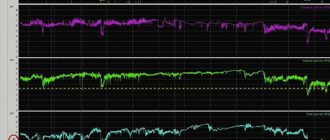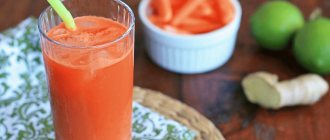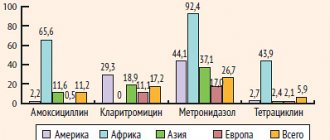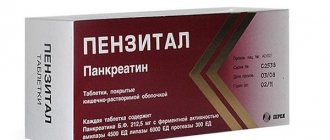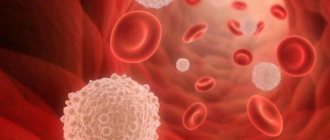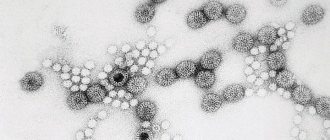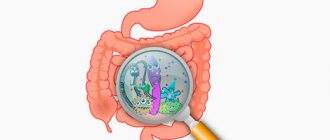Pharmacodynamics and pharmacokinetics
Pharmacodynamics
Antiulcer drug, a representative of proton pump inhibitors. Blocks the secretion of hydrochloric acid (the final stage), reducing stimulated and basal secretion. Penetrates well into the cells of the stomach, providing a cytoprotective effect.
The antisecretory effect occurs within an hour, and the total duration of action is 48 hours. Restoration of secretory activity is observed 3 days after the end of treatment. The drug has no effect on the cardiovascular system and central nervous system.
Pharmacokinetics
Absorbed in the small intestine, the degree of absorption is high. Cmax in the blood is determined after 3.5 hours. Bioavailability is about 52%, and it does not increase with repeated use. 97% bound to blood proteins. Metabolized in the liver with the participation of the cytochrome system. Excreted by the kidneys. T1/2 is 1.5 hours.
Khairabezol, 30 pcs., 10 mg, enteric-coated tablets
Absorption
Rabeprazole is rapidly absorbed from the intestine and peak plasma concentrations (Cmax) are achieved approximately 3.5 hours after a 20 mg dose. Changes in peak plasma concentrations and area under the pharmacokinetic concentration-time curve (AUC) of rabeprazole are linear in the dose range from 10 to 40 mg. Absolute bioavailability after oral administration of 20 mg (compared to intravenous administration) is approximately 52%. In addition, bioavailability does not change with repeated dosing of rabeprazole. Neither the time of taking the drug during the day nor antacids affect the absorption of rabeprazole. Taking the drug with fatty foods slows down the absorption of rabeprazole by 4 hours or more, but neither Cmax nor the degree of absorption changes.
Distribution
In humans, the degree of binding of rabeprazole to plasma proteins is about 97%. Metabolism
Rabeprazole is metabolized in the body in two ways. A significant part of it is metabolized systemically by a non-enzymatic route with the formation of thioester derivatives. Rabeprazole is also metabolized in the liver via cytochrome P450 to form sulfonic and desmethyl derivatives.
In healthy volunteers, the plasma half-life is approximately 1 hour (varies from 0.7 to 1.5 hours), and the total clearance is 3.8 ml/min/kg.
Removal
After a single oral dose of 20 mg of 14C-labeled rabeprazole, about 90% of the drug is excreted in the urine, mainly in the form of carboxylic acid thioester, its glucuronide and in the form of mercapturic acid derivatives. No unchanged drug is detected in the urine. The remainder of the rabeprazole taken is excreted through the intestines. The total elimination is 99.8%.
End stage renal failure
In patients with stable end-stage renal disease who require maintenance hemodialysis (creatinine clearance <5 ml/min/1.73 m2), the elimination of rabeprazole is similar to that of healthy volunteers. AUC and Cmax in these patients were approximately 35% lower than in healthy volunteers. On average, T1/2 of rabeprazole was 0.82 hours in healthy volunteers, 0.95 hours in patients during hemodialysis and 3.6 hours after hemodialysis. Clearance of the drug in patients with kidney disease requiring hemodialysis was approximately twice as high as in healthy volunteers.
Chronic compensated cirrhosis
Patients with chronic compensated liver cirrhosis tolerate rabeprazole 20 mg once daily, although AUC is doubled and Cmax is increased by 50% compared to healthy volunteers.
Elderly patients
In elderly patients, the elimination of rabeprazole is somewhat slower. After 7 days of taking rabeprazole at a dose of 20 mg 1 time per day in elderly individuals, AUC was approximately twice as high and Cmax was increased by 60% compared to young healthy volunteers; There were no signs of drug accumulation.
СYР2С19 polymorphism
In patients with slow metabolism via the CYP2C19 isoenzyme, after 7 days of taking rabeprazole at a dose of 20 mg per day, the AUC increases by 1.9 times and the half-life by 1.6 times compared with the same parameters in “rapid metabolizers”, while how Cmax increases by 40%.
Side effects
Most common adverse reactions:
- diarrhea , nausea;
- headache.
Less common adverse reactions:
- vomiting, flatulence ;
- abdominal pain and constipation;
- dizziness;
- insomnia;
- nervousness;
- depression;
- myalgia , seizures;
- arthralgia;
- cough, sinusitis ;
- sweating , weight gain;
- rash, itching;
- thrombocytopenia , leukopenia , leukocytosis .
Khairabezol, instructions for use (Method and dosage)
Khairabezol tablets are taken orally, in the morning before meals, swallowed without chewing.
Peptic ulcer during exacerbation - 20 mg 1 time in the morning for up to 6 weeks. The dose for children 12 years old is 20 mg once a day.
GERD - once a day for up to 8 weeks. Maintenance treatment is carried out at a dose of 10 mg 1 time per day. For GERD without esophagitis, take 10 mg per day, month.
Khairabezol 20 mg is included in Helicobacter pylori eradication regimens in combination with Clarithromycin and Amoxicillin .
If renal or liver function is impaired, the dose is not reduced. Withdrawal of the drug does not result in rebound syndrome. Secretion is restored in 2-3 days.
Khairabezol (Rabeprazole) TB po intestinal 20 mg N 15
Active substance
rabeprazole
ATX code
A02BC04 (Rabeprazole)
Release form, packaging and composition of the drug
Enteric film-coated tablets
light pink to reddish pink, round, biconvex; On a cross section, the kernel is white or white with a yellowish tint.
| 1 tab. | |
| rabeprazole sodium | 10 mg |
[PRING] magnesium oxide - 50 mg, mannitol - 17.5 mg, corn starch - 2.5 mg, povidone K30 - 1.5 mg, low-substituted hyprolose - 16 mg, sodium stearyl fumarate - 2 mg.
Shell composition:
cellacephate - 11.25 mg, titanium dioxide - 1 mg, red iron oxide dye - 0.1 mg.
10 pieces. - blisters (1) - cardboard packs. 10 pieces. - blisters (10) - cardboard packs. 10 pieces. — strips (1) — cardboard packs. 10 pieces. — strips (10) — cardboard packs. 14 pcs. - blisters (1) - cardboard packs. 14 pcs. - blisters (2) - cardboard packs. 14 pcs. — strips (1) - cardboard packs. 14 pcs. — strips (2) — cardboard packs. 15 pcs. - blisters (1) - cardboard packs. 15 pcs. - blisters (2) - cardboard packs. 15 pcs. - blisters (10) - cardboard packs. 15 pcs. — strips (1) — cardboard packs. 15 pcs. — strips (2) — cardboard packs. 15 pcs. — strips (10) — cardboard packs.
Enteric film-coated tablets
light yellow to yellow, round, biconvex; On a cross section, the kernel is white or white with a yellowish tint.
| 1 tab. | |
| rabeprazole sodium | 20 mg |
[PRING] magnesium oxide - 69 mg, mannitol - 40 mg, corn starch - 2.5 mg, povidone K30 - 1.5 mg, low-substituted hyprolose - 24 mg, sodium stearyl fumarate - 2 mg.
Shell composition:
cellacephate - 18 mg, titanium dioxide - 1.6 mg, iron dye yellow oxide - 0.16 mg.
10 pieces. - blisters (1) - cardboard packs. 10 pieces. - blisters (10) - cardboard packs. 10 pieces. — strips (1) — cardboard packs. 10 pieces. — strips (10) — cardboard packs. 14 pcs. - blisters (1) - cardboard packs. 14 pcs. - blisters (2) - cardboard packs. 14 pcs. — strips (1) — cardboard packs. 14 pcs. — strips (2) — cardboard packs. 15 pcs. - blisters (1) - cardboard packs. 15 pcs. - blisters (2) - cardboard packs. 15 pcs. - blisters (10) - cardboard packs. 15 pcs. — strips (1) — cardboard packs. 15 pcs. — strips (2) — cardboard packs. 15 pcs. — strips (10) — cardboard packs.
Clinical and pharmacological group
H+-K+-ATPase inhibitor. Antiulcer drug
Pharmacotherapeutic group
Proton pump inhibitor
pharmachologic effect
Suction and distribution
Absorbed from the small intestine (due to the presence of an acid-resistant enteric coating). Absorption is high, time to reach Cmax is 3.5 hours. Cmax and AUC values are linear in the dose range from 10 to 40 mg. Bioavailability - 52%, does not increase with repeated doses.
Communication with plasma proteins - 97%.
Metabolism and excretion
Metabolized in the liver with the participation of cytochrome P450 isoenzymes (CYP 2C19 and CYP 3A4).
T1/2 - 0.7-1.5 hours, clearance - 283 ± 98 ml/min. Excreted by the kidneys - 90% in the form of two metabolites: a conjugate of mercapturic acid (M5) and carboxylic acid (M6); intestines - 10%.
Pharmacokinetics in special clinical situations
In patients with mild or moderate chronic liver failure, after a single dose, AUC increases by 2 times, T1/2 by 2-3 times. After taking 20 mg of rabeprazole for 7 days, AUC increases by 1.5 times, T1/2 - by 1.2 times. In patients with stable end-stage renal failure requiring hemodialysis (creatinine clearance less than 5 ml/min/1.73 m2), the distribution of rabeprazole sodium is close to that in healthy individuals.
In elderly patients, after taking rabeprazole for 7 days, AUC is 2 times greater, Cmax is 60% greater than in young patients.
In patients with slow metabolism of CYP2C19, after 7 days of taking rabeprazole at a dose of 20 mg per day, AUC increases by 1.9 times, and T1/2 by 1.6 times compared with the same parameters in “rapid metabolizers,” while Cmax increases by 40 %.
Indications for use
- peptic ulcer of the stomach and duodenum in the acute stage;
- gastroesophageal reflux disease;
- hypersecretory conditions, including Zollinger-Ellison syndrome;
- stress ulcers of the gastrointestinal tract.
As part of complex therapy:
- eradication of Helicobacter pylori in patients with gastric and duodenal ulcers or chronic gastritis;
- treatment and prevention of relapse of peptic ulcer associated with Helicobacter pylori.
Dosage
The drug is prescribed 20 mg 1 time/day. The tablets should be taken orally, in the morning before meals, swallowed whole, without chewing or crushing.
For duodenal ulcer and gastric ulcer in the acute stage
Prescribe 20 mg (1 tablet) 1 time/day in the morning for 4-6 weeks.
For gastroesophageal reflux disease (GERD)
prescribed 20 mg (1 tablet) 1 time/day for 4-8 weeks.
For maintenance therapy for GERD -
at a dose of 10 or 20 mg 1 time / day, depending on the patient’s response.
For the symptomatic treatment of GERD in patients without esophagitis -
at a dose of 10 mg 1 time/day for 4 weeks.
For the treatment of Zollinger-Ellison syndrome and other conditions characterized by pathological hypersecretion,
the dose is selected individually.
For the treatment of duodenal ulcer or chronic gastritis associated with Helicobacter pylori infection,
A course of treatment lasting 7 days with one of the following combinations of drugs is recommended:
Khairabezole 20 mg 2 times/day + clarithromycin 500 mg 2 times/day and amoxicillin 1 g 2 times/day.
Hairabezole 20 mg 2 times/day + clarithromycin 500 mg 2 times/day and metronidazole 400 mg 2 times/day.
Contraindications
- pregnancy;
- breast-feeding;
- children and adolescents up to 18 years of age;
- hypersensitivity to rabeprazole, benzimidazoles or other components of the drug.
Carefully _
the drug should be prescribed for severe liver failure, severe renal failure.
Overdose
Symptoms:
not described.
Treatment:
If an overdose is suspected, supportive and symptomatic therapy is recommended. Dialysis is ineffective.
Side effects
WHO classification of unwanted adverse reactions by frequency of development: very often - 1/10 prescriptions (≥ 10%), often - 1/100 prescriptions (≥ 1%, but < 10%), infrequently - 1/1000 prescriptions (≥ 0.1%, but < 1%), rarely - 1/10,000 prescriptions (≥ 0.01%, but < 0.1%), very rarely - less than 1/10,000 prescriptions (< 0.01%).
From the digestive system:
often - diarrhea, nausea; uncommon - vomiting, abdominal pain, flatulence, constipation; rarely - dry mouth, belching, dyspepsia; very rarely - impaired taste, anorexia, stomatitis, gastritis, increased transaminase activity.
From the nervous system and sensory organs:
often - headache; rarely - dizziness, asthenia, insomnia; very rarely - nervousness, drowsiness, depression, visual disturbances, taste disturbances.
From the musculoskeletal system:
rarely - myalgia; very rarely - arthralgia, cramps of the calf muscles.
From the respiratory system:
rarely - inflammation or infection of the upper respiratory tract, severe cough; very rarely - sinusitis, bronchitis.
From the hematopoietic organs and hemostasis system:
rarely - thrombocytopenia, leukopenia; very rarely - leukocytosis.
Allergic reactions:
rarely - rash, itchy skin.
Other:
rarely - pain in the back, chest, limbs, swelling, urinary tract infection, fever, chills, flu-like syndrome; very rarely - increased sweating, weight gain.
Overdose
Rabeprazole slows down the excretion of certain drugs metabolized in the liver by microsomal oxidation (diazepam, phenytoin, indirect anticoagulants).
Reduces the concentration of ketoconazole by 33%, digoxin by 22%.
Does not interact with liquid antacids.
Compatible with drugs metabolized by the CYP 450 system (warfarin, phenytoin, theophylline, diazepam).
Storage conditions
The drug should be stored in a dry place, protected from light, out of reach of children at a temperature of 8°C to 25°C. Shelf life: 2 years.
Conditions for dispensing from pharmacies
The drug is available with a prescription.
Special Instructions
Before and after treatment with rabeprazole, endoscopic monitoring is required to exclude malignancy, because treatment may mask symptoms and delay correct diagnosis.
Caution is recommended when first prescribing rabeprazole to patients with severely impaired liver function.
The drug does not affect the function of the thyroid gland, carbohydrate metabolism, the blood concentration of parathyroid hormone, cortisol, estrogen, testosterone, prolactin, cholecystokinin, secretin, glucagon, follicle-stimulating hormone, luteinizing hormone, renin, aldosterone and somatotropic hormone.
Patients with impaired renal or liver function do not require dose adjustment.
Withdrawal of the drug is not accompanied by the rebound phenomenon; the restoration of secretory activity occurs within 2-3 days as new enzyme molecules are synthesized.
Use in pediatrics
The drug is not recommended for use in children and adolescents, since there is no experience with the use of rabeprazole in pediatric practice.
Impact on the ability to drive vehicles and operate machinery
If drowsiness occurs during treatment, you should stop driving and other activities that require increased concentration and speed of psychomotor reactions.
Khairabezol's analogs
Level 4 ATX code matches:
Noflux
Lancid
Barol
Beret
Ontime
Gastrozol
Omeprazole
Pantoprazole
Proxium
Lansoprazole
Zulbex
Ultop
Epicurus
Pariet
Losek MAPS
Losek
Sanpraz
Emanera
Omez Insta
Omez
- Pariet
- Zulbex
- Zolispan
- Rabelok
- Razo
- Noflux
Reviews about Khairabesol
According to studies in which the drug was prescribed for the treatment of erosive and ulcerative defects of the stomach, on the 2nd day of therapy in 75% of patients the pain syndrome decreased, and after a week of use no one had any complaints. In 91% of patients, by the end of the 2nd week of treatment, according to the results of FGDS, healing of erosive and ulcerative defects . The drug has a persistent antisecretory effect; when taken, the number of refluxes decreases. All this is confirmed by patient reviews.
- “...The medicine Khairabezol was prescribed for an exacerbation of an ulcer. Feeling better within a day. I was treated for a month and the discomfort and pain in the stomach went away.”
- “...I liked the drug! The pain and heartburn disappeared. I used to take Pariet, but it is very expensive. I didn’t see any difference in the effectiveness of those and other tablets.”
- “... I take it for exacerbations of ulcers. It helps me personally. Conveniently, you only need to take it once a day and the package lasts for 15 days. Satisfied with the price and efficiency. I didn’t feel any side effects.”
Side effects included minor headache and constipation .
Khairabesol
Khairabesol
(
Hirabezol
) - a drug to reduce gastric acidity, a proton pump inhibitor, and an antiulcer.
Treatment of erosive and ulcerative defects of the stomach and duodenum with the drug Khairabezol is clinically effective and has a persistent antisecretory effect. During a study assessing the effectiveness of Hairabezol, the following was noted. A decrease in pain in the epigastric region is observed from the 2nd day of use of the drug, and by the 7th day of therapy, the pain syndrome, according to the study, disappears. In the vast majority of patients, healing of erosive and ulcerative defects was achieved by the end of the 2nd week. The percentage of daily time pH>4 in the stomach increased by more than 2.5 times, while the percentage of time pH<4 in the esophagus decreased on average by almost 3 times. The total number of refluxes per day decreased on average by almost 4 times (V.A. Akhmedov, O.V. Gaus, etc.).
general information
According to the pharmacological index, Khairabezol belongs to the group “Proton pump inhibitors”.
According to ATC, it belongs to the group “Proton pump inhibitors” and has the code “A02BC04 Rabeprazole”. Proton pump inhibitors (in particular, rabeprazole) are considered the most effective drugs for controlling symptoms and treating complications of GERD, such as reflux esophagitis and Barrett's esophagus (see Fifth Moscow Agreement // XIII Congress of the National Registry, March 12, 2013).
Manufacturer: Highglans Laboratories, India. Dispensed from pharmacies with a doctor's prescription.
Dosage forms and composition of Khairabezol
The active substance of Khairabezol
is
rabeprazole
.
Khairabezol is available in the form of enteric film-coated tablets. The tablets are round, biconvex.
Tablets containing the active ingredient rabeprazole sodium 10 mg
covered with a shell of light to reddish-pink color.
Tablets containing rabeprazole sodium 20 mg
covered with a light yellow or yellow shell.
The tablets contain excipients magnesium oxide, mannitol, corn starch, povidone K30, low-substituted hyprolose, sodium stearyl fumarate.
The enteric-soluble coating contains cellacephate, titanium dioxide and red iron oxide dye (for Hayrabezol 10 mg tablets) or yellow iron oxide dye (for Khairabezol 20 mg tablets).
Indications for use of Khairabezol
From the instructions for the drug Khairabezol it follows that it is prescribed:
- for the treatment of duodenal and gastric ulcers in the acute stage, as well as anastomotic ulcers;
- for the treatment of reflux esophagitis;
- for the treatment of various forms of gastroesophageal reflux disease (GERD): non-erosive, erosive and ulcerative;
- for maintenance therapy of GERD;
- for the treatment of Zollinger-Ellison syndrome and other conditions characterized by pathological hypersecretion;
- for the combined treatment of peptic ulcer disease associated
with
Helicobacter pylori
.
Directions for use and dosage of Khairabezol
Khairabezol tablets are taken orally whole, without chewing or crushing. The timing of taking Khairabezol and simultaneous food intake do not affect the effectiveness of the drug.
- For gastric ulcers in the acute stage and anastomotic ulcers, it is recommended to take 10 mg or 20 mg of Hairabezol per day once. The standard course of treatment is 6 weeks, but in some cases it can be extended to 12 weeks.
- For duodenal ulcers in the acute stage, it is recommended to take 20 mg of Khairabezol once a day for 2-4 weeks. The course of treatment can be extended to 8 weeks if necessary. In some cases, the therapeutic effect occurs with a daily dose of 10 mg of the drug.
- For the treatment of erosive GERD or reflux esophagitis, a 4-8 week course of treatment with Khairabezol 10 mg or 20 mg once a day is recommended. Treatment can be extended for another 8 weeks if necessary. For maintenance therapy of GERD, Khairabezol is taken in the same dosage, the duration of treatment is determined by the patient's condition.
- For non-erosive GERD (NERD) without esophagitis, Hairabezol should be taken 10 mg or 20 mg once a day. If symptoms do not disappear after 4 weeks of treatment, additional examination of the patient is necessary. After eliminating the symptoms, in order to avoid their recurrence, a single dose of 10 mg of Hairabezol on demand is recommended.
- Treatment of Zollinger-Ellison syndrome and other conditions characterized by pathological hypersecretion with Khairabezol involves individual selection of the dosage of the drug. Starting from 60 mg per day, the daily dose is gradually increased to 100 mg in a single dose or 120 mg divided into 2 doses. For some patients, split doses of the drug are preferable. Treatment should be continued as clinically necessary. In cases of Zollinger-Elison syndrome, treatment can last up to one year.
- Combined treatment of duodenal ulcers and chronic gastritis associated with Helicobacter pylori
involves taking 20 mg of Hairabezol and 500 mg of clarithromycin with 1 mg of amoxicillin or 400 mg of metronidazole twice a day for a week. The use of double doses of Khairabezol increases the effectiveness of three-component therapy (see Fifth Moscow Agreement // XIII Congress of the NOGR. March 12, 2013).
Use of Khairabezol for functional dyspepsia
The choice of Hairabezol as maintenance therapy in patients with functional dyspepsia is justified by the following facts (Butorova L.I. et al.):
- Carrying out a three-month course of maintenance therapy with Khairabezol in a daily dose of 10 or 20 mg in patients with functional dyspepsia significantly reduces the recurrence rate and severity of dyspepsia symptoms compared with the results of using prokinetics and antacids
- the use of Hairabezol at a dose of 20 mg daily allows maintaining clinical remission of the disease in 80% of patients with FD, and at a dose of 10 mg - in 70%
- rapid relief of dyspepsia symptoms when using 20 mg of Khairabezol gives grounds in some cases to recommend maintenance treatment with this drug in an “on demand” mode
- a three-month course of maintenance therapy with Khairabezol was found to be well tolerated; side effects are observed in approximately 3% of patients and are most often expressed in a mild headache that does not require discontinuation of the drug or the use of additional medications
- Khairabezol is safe for long-term use and can be used in conjunction with other medications, including antacids
- Khairabezol has different dosages in tablet form (10, 20 mg) and differs from similar products in lower cost
Restrictions on use and contraindications
Khairabezole should be administered with caution to patients with severe hepatic impairment, since the AUC of rabeprazole in them is approximately 2 times higher than in healthy people.
Elderly patients and patients with renal insufficiency do not require dose adjustment.
Khairabezole should not be prescribed to children and adolescents under 18 years of age, pregnant and lactating women, since there are no sufficient studies to confirm the safety of rabeprazole in these categories of patients.
The FDA Fetal Risk Category for rabeprazole in pregnant women is C (animal studies have shown adverse effects of rabeprazole on the fetus and there have been no adequate studies in pregnant women, but the potential benefits associated with the use of this drug in pregnant women may justify its use despite at the existing risk).
Other medicines containing the active ingredient rabeprazole
In Russia, the following drugs with the active ingredient rabeprazole have been registered for sale in pharmacies: Bereta, Zolispan, Zulbex, Noflux, Ontime, Pariet, Rabelock, Rabeprazole-OBL, Rabeprazole-SZ, Rabiet, Razo. Most of them are available in the form of tablets for oral administration, coated with an intestinal soluble coating, containing 10 or 20 mg of the active substance - rabeprazole.
Side effects of Khairabezol
Side effects when taking Khairabezol most often occur from the digestive system (diarrhea, nausea) and from the nervous system (headache).
Materials for healthcare professionals regarding the use of Hairabezol
Articles
- Akhmedov V.A., Gaus O.V., Kiselev I.E., Kravtsova A.P. Evaluation of the effect of rabeprazole (drug "Hairabezol") 20 mg on 24-hour gastric pH-metry in patients with Hp-negative erosive and ulcerative lesions of the stomach and duodenum // Gastroenterology of St. Petersburg. 2015. No. 1–2. pp. 2–5.
- Akhmedov V.A., Gaus O.V. and others. Evaluation of the effectiveness of the drug hairabezol for the treatment of patients with erosive and ulcerative lesions of the stomach and duodenum // XX Ros. Gastroenterology Week October 6-8. RZHGGK. 2014. No. 5. P. 15.
- Orlov I.N. Diagnostic capabilities of 24-hour gastric pH metry in assessing the clinical effectiveness of the drug “hairabezol” in patients with negative erosive and ulcerative lesions of the stomach and duodenum // Abstracts of the VI International Youth Medical Congress “St. Petersburg Scientific Readings - 2015”. P. 50.
- Butorova L.I., Osadchuk M.A., Osadchuk M.M., Tokmulina G.M., Plavnik T.E., Smirnova N.A.. Optimization of therapeutic tactics for functional dyspepsia syndrome // Doctor.Ru. Gastroenterology. 2015. No. 12 (113). pp. 80-86.
- Spivakovsky Yu.M., Chernenkov Yu.V., Spivakovskaya A.Yu. and others. PPIs in the treatment of chronic gastroduodenitis in children. Materials XIX Ross. congr. "Innovative technologies in pediatrics and pediatric surgery." Russian Bulletin of Perinatology and Pediatrics.2020,65(4)223-4.
On the website GastroScan.ru in the “Literature” section there is a subsection “Rabeprazole”, containing articles devoted to the treatment of diseases of the gastrointestinal tract with rabeprazole preparations.
Video
Still from video by Partsvania-Vinogradova E.V. The role of pH-metry in acid-dependent diseases.
Still from video by E.S. Vyuchnova Tactics for managing patients with duodenogastric/biliary reflux
On the website GastroScan.ru in the “Video” section there is a subsection “For doctors”, containing video recordings of reports, lectures, webinars in various areas of gastroenterology for healthcare professionals, as well as a subsection “For students of medical universities”
Khairabezol has contraindications and side effects. Before use, you should consult a specialist. Back to section
Hayrabezol price, where to buy
You can buy Khairabezol in all pharmacies. Tablets of 20 mg are offered at a price of 500-600 rubles, the cost of tablets of 10 mg is 300-400 rubles.
- Online pharmacies in RussiaRussia
ZdravCity
- Khairabezol tablets p.p.o.
enteric solution 10 mg 15 pcs. Highglans Laboratories Pvt. Ltd IN RUR 410 order - Khairabezol tablets p.p.o. enteric solution 20 mg 15 pcs. Highglans Laboratories Pvt. Ltd IN
RUR 583 order
- Khairabezol tablets p.p.o. enteric solution 20 mg 30 pcs. Highglans Laboratories Pvt. Ltd IN
RUB 885 order
- Khairabezol tablets p.p.o. enteric solution 10 mg 30 pcs. Highglans Laboratories Pvt. Ltd IN
RUR 573 order
